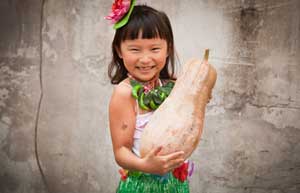Why the character for 'family' has a pig inside a house
Updated: 2011-10-07 10:16
By Huang Weijia (黄伟嘉) and Huang Dekuan (黄德宽) (China Daily)
|
|||||||||

"家"是人居住的地方,可是最早的"家"字里面为什么画的是一头猪呢?
家 means home.
The character 家 (jia) first appeared over 3,000 years ago on Shang Dynasty (c.16th century-11th century BC) bronzes. At that time, it was just a drawing that depicted a house with a pig inside it. Looking at the pictures, you can see that while one is quite complex and the other very simple, they're both lifelike.
Later, there were significant changes to the form of the character. On Shang Dynasty oracle bones, the character 家 slowly loses the feeling of being a drawing, and today's 家 is written with some of the strokes used to write all modern characters: dots, horizontal strokes, downward diagonal strokes both right and left, and so on. Although the form has changed, the structure hasn't. The top of the modern character (宀) still represents a house, and the 豕 below still represents a pig.
What was the earliest meaning of this character? More than 2,000 years ago, the first Chinese dictionary defined it as "home". In other words, 家 is a place where people live. So why is there a pig inside it and not a person?
One way of explaining it is that by the Shang Dynasty, animal husbandry had already been developed. People had domesticated pigs, sheep, oxen and horses. Because pigs were kept indoors with their owners, having a pig inside the house indicated that it was a place where people also lived; that's why "a house with a pig in it" could be used to write a character that meant "the place where people live". Sometimes in the oracle bones one can even see versions of 家 that depict a house with two pigs inside.
In the 3,000 years between the Shang Dynasty and the modern era, 家's meaning has been extended to include things that are related to home. The modern is most often used to mean "family" and "the place where a family lives". For example, when we say "our 家 has five people" or "the father is the master of the 家" it means family. When we say "our 家 is in Beijing, and going back to our 家 is very easy", the meaning is "the place where our family is".
家 can also be used to describe a certain kind of person or indicate an identity, as in 渔家 (yu jia, fisherman), 农家 (nong jia, farmer) and 东家 (dong jia, landlord). Additionally, 家 can be added to designate a school of thought. For example, 儒家 (Ru jia, Confucianism), 道家 (Dao jia, Daoism), 百家争鸣 (bai jia zheng ming, 100 schools of thought contend), and 一家之言 (yi jia zhi yan, one particular school of thought).
家 is also used to express a person who has mastered a specialized area of knowledge or a specific activity, like 专家 (zhuan jia, expert), 科学家 (ke xue jia, scientist), 社会活动家 (she hui huo dong jia, social activist), 画家 (hua jia, artist), 音乐家 (yin yue jia, musician), and 舞蹈家 (wu dao jia, dancer). The 兵家 in the expression 胜败乃兵家常事 (Sheng bai nai bing jia chang shi, victory and defeat are common in military operations) refers to someone who has mastered military affairs.
Sometimes, as a way of showing respect, people will call experts 大家 (da jia). For example, you might say that somebody is a calligraphy 大家, or somebody is a literary 大家. Here, we must be careful not to confuse this 大家 with the 大家 that's used to mean "everybody", as in ""请大家安静 (Qing da jia an jing. "Please be quiet, everyone.")
- Translated by Charlie Custer (葛亚辉)
Courtesy of the World of China, www.theworldofchinese.com










